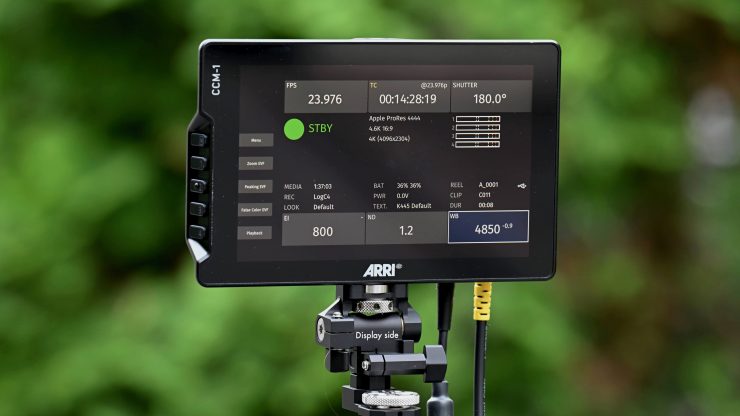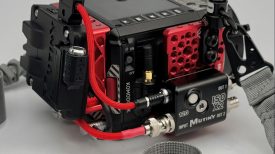
ARRI has released SUP 7.3 for the ALEXA Mini LF. This latest software release for ALEXA Mini LF is all about control and interface enhancements, and it opens up compatibility with the Camera Control Monitor CCM-1 and enables touchscreen operation of the MVF-2 flip-out monitor.

ALEXA Mini LF SUP 7.3 Changes Overview
• Camera Control Monitor CCM-1 Support
• Touch on Multi Viewfinder MVF-2
• Extended Erase Media menu warnings
• Improved Audio Gain GUI
• CAP additions and bugfixes
• WPA-3 Support
• LAN Gateway Setting
• ECS Improvements

The ALEXA Mini LF now joins the ALEXA 35 in offering support for ARRI’s new Camera Control Monitor CCM-1. I recently reviewed the CCM-1 on the site and you can read that review here. The CCM-1 provides full camera control and menu access, combining ARRI color accuracy and a bright display with customizable controls, rugged build quality, and some nice accessories.
The CCM-1 User Buttons can be assigned either from the camera or the CCM-1 itself.

MVF-2 MENU > User Buttons > Monitor User Buttons
To guarantee stable functionality of the CCM-1 with the new SUP 7.3 for ALEXA Mini LF, please make sure your CCM-1 is also running the latest software version: SUP 5.5.1.
Other new features in SUP 7.3 include the enabling of touchscreen operation of the flip-out monitor on the MVF-2 viewfinder. While the hardware has always had this capability, it is only now that the user interface has been developed to a point where touchscreen functionality can speed up workflows on set and in prep.

The setting is activated by default and can be changed in MENU > System > Buttons + Display. Together with this change, ARRI has introduced numerous adjustments to the menu. You can switch between the live screen and the menu screen by sliding either screen sideways with your finger. The Lock switch on the MVF-2 now also disables touch in addition to locking the buttons.
ALEXA Mini LF SUP 7.3 also introduces other benefits such as support for WPA-3 client mode, an extended erase media warning, support for LAN static gateway settings, and a lot of stability improvements.

The erase media warnings on the MVF-2 flip-out monitor have been modified to offer more information about the media erase process. The color of the title background of the warning messages clearly communicates if there are camera clips on the card that are about to be erased (red title background) or not (orange title background).

In addition to that, there is a clear second step to initiate the erase process to avoid accidental operation.

The new Audio Gain screen gives a quick overview of the current gain settings, the channel assignments, and monitoring settings. Gain levels can be adjusted by turning the MVF-2 click wheel or dragging on the scroll bar with your finger. You can access this by going to MVF-2 MENU > Recording > Audio Recording > Gain Levels

In certain setups, especially for virtual productions, there is a need to define a network static gateway. The default static gateway is a router that forwards network packets when no other route matches the destination of a packet. In a local network, the default gateway is typically the host that is one hop closer to the internet. The IPv4 address of the gateway typically is the first address in a subnet, e.g. 192.168.0.1. As a factory default, the gateway is set to 0.0.0.0. To access these settings you can go to MENU > System > Network/WiFi > LAN Static Gateway
The camera now also fully supports the CAM (7p) – LBUS (4p) connection to the ARRI Electronic Control System (ECS). As introduced with the ALEXA 35, the CAM port of an ECS motor controller (e.g. RIA-1, ZMU-4) can now be connected to the LPL mount LBUS port. This interface is superior to the CAM (7p) – EXT (6p) connection as camera control commands and lens metadata are transferred. Connection via EXT (6p) is still possible, but not recommended.
The cforce mini RF in radio host mode will support the CAM (7p) – LBUS (4p) connection with the next firmware update. It must be connected via CAM (7p) – EXT (6p) when using firmware SUP 2.0.3 or older.
A calibrate all command triggered from an ECS hand unit now calibrates all F / I / Z motors connected to the ALEXA Mini LF. This includes motors that are assigned to another control unit, that are completely unassigned, or in encoder mode. In the past, only the lens motors that were actively controlled by the corresponding ECS hand unit were calibrated. An AUX motor must always be calibrated manually and will not be calibrated via calibrate all. This change has already been introduced to the Radio Interface Adapter (RIA-1) and to the ALEXA 35. It will be rolled out to all
ARRI motor controllers and cameras in the future.
Updating
ALEXA Mini LF SUP 7.3 can be installed on all previously shipped ALEXA Mini LF cameras, and ARRI recommends updating from ALEXA Mini LF SUP 7.2 to SUP 7.3. However, they do not recommend updating to a new SUP in the middle of a production.
Important note: no device should be connected to the LPL mount during an update, otherwise the update will fail and must be executed again.
Downdating
It is possible to downdate from ALEXA Mini LF SUP 7.3 to an older SUP. However, MVF-2 viewfinders with serial numbers above 6849 and Compact Drive 2TB units with serial numbers starting with 273xxxxx are not compatible with older ALEXA Mini LF SUPs.
Known Software Issues
Lenses
ALURA 1.4x and 2.0x Extender are not recognized by the camera and therefore the lens information shown in the menu, the SDI overlays and the WCU-4 show the information of the lens without considering the use of the extenders.
Monitoring
Artifacts on SDI when toggling exposure tool and Color Space is REC 2020. If an SDI output is set to Color Space REC 2020 and the exposure tool on the MVF-2 is used artifacts can be observed on the SDI output. This is critical if that ouput is being broadcasted or recorded.
MVF-2 can show subtle flickering in upper part. Sometimes a subtle flickering can be observed in the upper part of the image of the MVF-2 viewfinder (through the eyepiece, not the flip-out monitor).
Brightness flicker when EVF Zoom is activated or EVF Surround view is off
Brightness flicker in the upper part of the OLED display can be noticed.
Magnification Limits
Depending on the recording format, the MAGNIFICATION feature can sometimes reach maximum magnification before the top value of 200% is reached. In this case, higher value numbers will be shown in the menu, but actual image magnification will not increase further.
Magenta Image after Mode switch
Sometimes after switching Recording Modes the SDI image may display a magenta tint for up to 5 seconds before returning to the normal image.
Playback
Lower Audio levels in Playback. When playing back a clip with Audio the headphone output on MVF-2 is 3dB less than in Live/Recording.
Post
No Mirror image function for MXF/Apple ProRes in DaVinci Resolve. The vertical “Mirror image” function does not work for MXF/Apple ProRes in DaVinci Resolve. However, it will work with ARRIRAW.
Remote Control
Web Remote: Periodic connection issues. When using the Web Remote with certain OS / Browser combinations the camera may not be found. Use the LAN IP address of the camera in those cases. Check MENU > INFO > NETWORK INFO LAN IP for the current IP address.
WiFi – No successful reconnection to access point after reboot in client mode. In rare cases the WiFi driver can get stuck after a reboot or resolution change when the camera is in client mode. In this case the camera does not reconnect to the previous access point and the list of discovered networks is empty. In this case, please reboot the camera to regain WiFi functionality.
Sync
SDI out of sync. If two cameras are being synchronized by syncing only one of them to timecode, the recorded images will be in sync, but the SDI outputs will be slightly out of sync. Supply timecode to both cameras to mitigate this issue.
Warning message unavailable
A camera in setting client mode inherits all settings from the host camera. When attempting to change settings on a camera in settings client mode not all items prompt the warning that these settings can only be changed on the host camera, but instead are not modifiable.
Disabling EXT Sync leads to error message
When disabling EXT Sync the camera can display a software error (#4) and prompt the user to reboot. After rebooting the camera will resume working as expected.
Timecode offset after exiting playback through recording
When exiting playback by pushing the REC button, it is possible for timecode to be offset by one frame. To avoid this, exit playback by pushing the physical playback button on the viewfinder or through the ‘close’ button in the menu.
EXT Sync: changing codec is not supported
In an EXT Sync setup when changing the recording codec on Host puts any Client in a reboot loop. Adjust the codec as needed before setting up EXT Sync.
Usability
Cannot overwrite existing User Pixel Mask. Saving a User Pixel Mask on the USB stick is only possible when the sensor folder on the USB stick does not already contain a User Pixel Mask. If you want to save a User Pixel Mask, make sure the folder is empty or re-name any existing User Pixel Masks. Even then, sometimes a new User Pixel Mask cannot be saved, and the monitor gets stuck with the message ‘Exporting user pixel mask, please wait…’. Restarting fixes all of this.
MVF-2 stays black on camera start
In rare cases the MVF-2 can stay black after the camera has been booted completely. Replug the Viewfinder in this case.
Updating
ALEXA Mini SUP camera update might fail. In a few cases the camera update may fail with the message ‘Last SUP installation was incomplete. Please re-install SUP. (#135)’. In this case, please re-install SUP.
Known Issues – Mechanical Accessories
RAB-1 Clamp 2 may experience poor clamping performance. Some early RAB-1 Clamp 2 units (K2.0023406) ran into assembly issues leading to poor clamping performance or the inability to release adequately. If a RAB-1 Clamp 2 is found to slip on the Rear Accessory Bracket RAB-1 (K2.0013937)
or not to release correctly, please contact ARRI Service to get the part repaired or exchanged.
Compact Bridge Plate CBP-1 and CBP-2 lever malfunction
To release the Compact Bridge Plate CBP-1 or CBP-2 from a balance plate, the safety catch on the main locking lever of the CBP must be released for the main locking lever to be moved from the BALANCE to the RELEASE position. Some early CBP-1 and CBP-2 units could have the main locking lever moved directly from the LOCK position to the RELEASE position. In that case, please contact ARRI Service to get the part repaired or exchanged.





